Update from Charlotte Beskow in Kourou with the ATV-5 launch campaign team – Ed.
Diary from a Space Project: ATV5 23-31 May, 2014
It is the last time an ATV banner will hang in S5C.
23 May – Bringing down the ATV banner
Airbus DS finish clearing out S5C South and the handover to CSG is performed. The final task is to remove the two ATV banners. It is the last time an ATV banner will hang in S5C. Simple n’est-pas? Well… not really. It needed a man lift and two operators; it was a pretty tight fit!
Next: Setting up for the gas loading dry run and the filling of the ESA EML experiment. In the foreground of the image below, you see the various project gas bundles used for filling operations. In the background, the gas loading equipment is being readied for the set up and dry run (which is done in S5C in order to save time). The whole train of equipment is then moved to S5B via the corridor.
Since the area is quite packed with equipment, the simple task of moving a blast shield in place – this required for the filling of the ESA EML (Electromagnetic levitator) experiment which will fly to ISS as ESA cargo – becomes a bit more challenging. Yes, it has wheels but… with all the equipment in the way, it has to be lifted using the crane and then swung gently round and eased into position.
27 May – Fuelling with NTO (Nitrogen Tetroxide)
It’s 12:29, and NTO propellant loading is about to start.
560 kg of Nitrogen Tetroxide will be loaded, 280 kg into each of the two tanks. That will complete the loading of Russian fuel.
The Main Inspection Point (MIP) for this operation took place yesterday, 26 May, and ended with an inspection of the loading set-up at 20:00 in the evening.
This picture was taken a few days earlier, and shows the NTO degassing set-up. Degassing is one of the steps to prepare for NTO loading.
The message on the loudspeaker just now announced the start of the operation.
All is set for NTO loading; it looks deceptively simple.
The operator stays close to the control panel, waiting for the order to turn a valve.
One of the first steps (which is just being completed as this is being written) is to flush the lines. Once this action is completed, the actual fuelling can start.
The fuel lines are narrow, so it takes a certain time and during this interval the operators, in their protective suits (weighing between 10 and 15 kg) stay close to the valves, ready to intervene.
Everything is supervised (remotely) by the test conductor and by CSG safety personnel. I can take the picture shown above because the images from the clean room are relayed to our office via internal TV. This means we can follow the ongoing work. Regular safety announcements resonate throughout the entire EPCU (French acronym for Payload Preparation Building), alerting us to the start and end of safety critical operations.
In case of any problem (with radio communications, ventilation in the suit, air supply, propellant, etc.), specially trained staff (firemen from Pompiers de Paris) are close by, ready to react.
28 May – O2 loading
Following the successful completion of NTO loading today, we are almost ready for the next steps in the filling process: Oxygen loading, air loading and the set-up for MMH loading. But, a couple of nominal hazardous operations need to be completed first.
Unloading of the NTO Cold Trap and removing the fuel drums is one such operation.
The fuel we load is toxic, so this operation is done in the same heavy 15 kg suits as seen in the picture earlier. During the fuelling process some fuel has been collected in a cold trap and now, after thawing for 6 hours, this is ready to be transferred to the waste drum whereupon it can be removed from S5B and transported to the ‘fuel farm’.
Funny name by the way; we do not actually grow any fuel!
Until this operation is completed and the room made ready, the next oxidiser (MON to be loaded into ATV tanks) cannot be delivered.
The unloading was completed by 09:00 (they started at 06:00) and the transport was completed; whereupon the MON tank arrived.
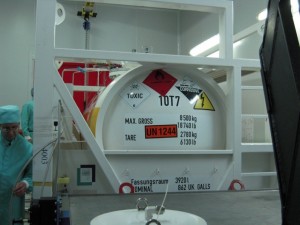
This is actually a picture of the MMH tank taken for a previous ATV, but they are similar. Credit: ESA
This is actually a picture of the MMH tank taken for a previous ATV, but they are similar.
In the S5C meeting rooms, the MIP for gas loading gets under way. This is the readiness point to check that all is in place for loading Oxygen (67 kg) and air (33 kg) loading, an operation that will take place during the Whitsunday weekend: Friday, 30 May, O2 loading; and, Saturday, 31 May, air loading.
22-24 May – Planning issues
The fluidic and transport teams have their hands full managing the scheduling of all these events.
In normal times, these operations follow a standard timeline, but ‘Murphy’ decided to inject a few extra hurdles into the show for ATV5. The majority of the tasks are hazardous for some part of their duration and there are strict rules in place to ensure security for all personnel. This means that we have to not only take care of our own hazardous ops planning but also consider the availability of CSG safety personnel and (in the case of ATV5) the concurrent launch campaign for Ariane VA 218 (set for launch on 28 May).
As soon as the combined teams – Airbus Defence & Space, ESA, CSG, Arianespace – had worked out a plan that took into consideration all the known bottlenecks for VA 218 launch on 28 May, the launch date shifted to 6 June (with fuelling of one of the payload satellites, in S5A, on 22 and 24 May). We immediately did a new round of replanning / coordination… (and the long weekends in May do not exactly help!) to come up with a new schedule that allowed us to leave our main goal unchanged.
Thursday, 22 May, all was agreed… Friday, 23 May, the planning changed yet again when VA218 was postponed until after ATV.
Conclusion : ATV5, on board VA 219, is now the next Ariane launch.
30 May – O2 & air loading
As with everything else on this project, the operation seems simple but actually involves a series of steps performed over several days
| 26 May | WGLU Installation in S5C |
| 27 May | GOx loading set-up pre-test in S5C |
| 27 May | Set up certification in S5C |
| 27 May | Dry Run in S5C w/He |
| 28 May | MIP-41 Gas Loading Readiness Review |
| 30 May | Transfer to S5B |
| 30 May | Prep of set up in S5B |
| 30 May | Pressurisation of tanks (i.e. loading) with 67 kg Oxygen for the ISS |
| 31 May | Completion of the O2 loading followed by pressurisation of tanks (i.e. loading) with 33kg air for the ISS |
In parallel with all this, the Airbus DS team with support from Friedrichshafen have filled the gas bottles for the ESA EML payload, which will be flown as cargo to the ISS (also a hazardous operation, by the way).
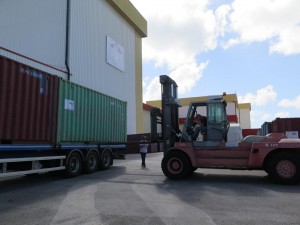
You can see a corner of the ICC container standing behind the truck, waiting for transport to the harbour. Credit: ESA
Then as soon as this is done – preparations continue with set up for MMH loading. This is planned for 4-5 June (three-shift operation, which runs overnight). Plus, of course, the packing of equipment no longer needed and due for shipment back to Europe.
You can see a corner of the ICC container standing behind the truck, waiting for transport to the harbour.
– Charlotte


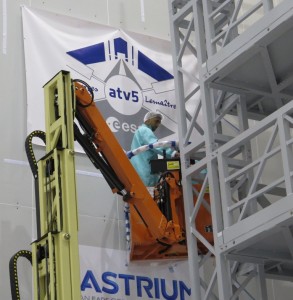
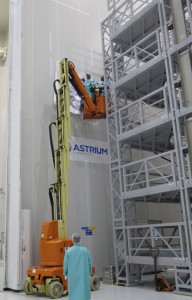
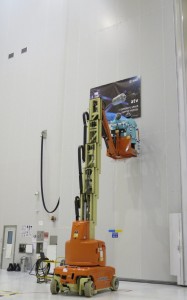
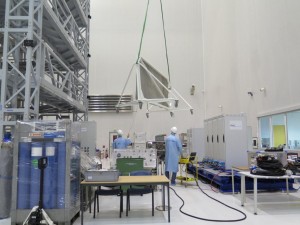
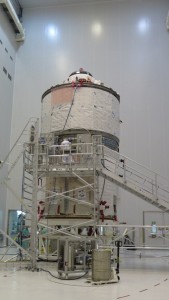
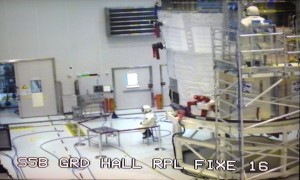

 Automated Transfer Vehicle page
Automated Transfer Vehicle page ATV blog archive
ATV blog archive
Discussion: no comments